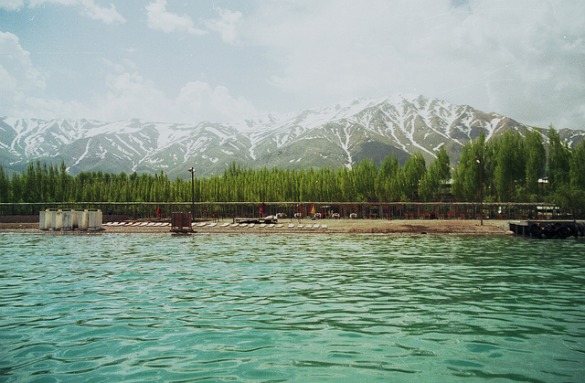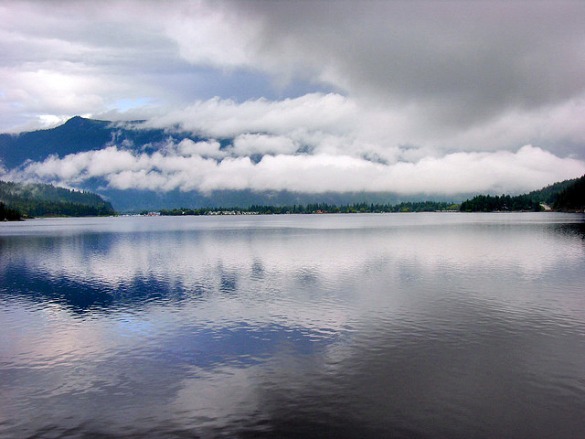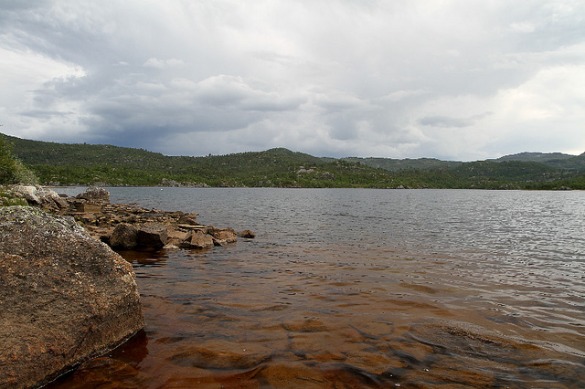Where do spirits whisper? Where do Gods reside? Where do monsters lurk? Throughout history, high mountains, dense woods and bottomless lakes have been associated with people’s beliefs and imagination. Wonders of nature appear to be the only befitting dwellings for Gods, spirits and awe-inspiring creatures.
Whereas Gods and ghosts are purely spiritual, lake monsters are another matter, a subject which offers itself to scientific examination. Modern technology makes it possible to penetrate even the deepest waters in search of proof of the existence of these monsters which have fired the imagination of locals and visitors alike. Do they really exist or are they only a product of fantasy? Why are certain lakes associated with monsters and others, located in equally spectacular surroundings, do not have their local monster? And where in the world are they to be found? The answer to the last question is: more places that you might think. A look at seven lakes and their resident monsters reveals the similarities and the differences in ‘monster culture’ around the world.
Van Gölü Canavari – monster of Lake Van in Turkey
Lake Van, in eastern Turkey near the border with Iran, is Turkey’s biggest lake at74 miles across at its widest point and – at its deepest – 1480 feet . Surrounded by steep mountains, some of them snow covered and stagnant as the lake has no outlet, it doesn’t come as a surprise that a Plesiosaur is believed to plow the waters.
Of all the monsters we are going to look at, the canavari is the youngest in the sense that sightings of a creature about 15m long and with spikes on its back, have only been reported as recently as 1995. Approximately 1000 people claim to have seen the monster; the highlight came in 1997 when a local university assistant by the name of Unal Kozak filmed a video and even wrote a book about the monster. Both have been met with a lot of criticism and the Turkish government even mounted a scientific expedition which revealed…nothing.
This part of Turkey is underdeveloped in terms of tourism and rumor has it that the monster is a publicity stunt to attract more visitors. If so, it certainly did the trick, because I went to visit the Lake in search of the monster and stories about it. However, when I mentioned my quest, I got a lot of laughter in response and was referred to a popular cartoon which makes fun of Kozak’s video. I didn’t find the statue of the monster either, neither in Van nor in the town of Gevas which is the starting point for boats to Akdamar island. In the city of Van, however, they do have a monument of the only species of fish which lives in the lake.
>> Book flights to Turkey and check out things to do in Turkey
Ogopogo – monster of Lake Okanaga in British Columbia
Whereas my inquiries about the Van Lake monster were met with laughter, questions about Ogopogo, the Lake Okanaga resident monster, got a different response. Perceived by the First Nations people, who live along the shore and call the beast Naitaka in their language, as a malevolent creature, it is feared as attacking and devouring animals and, maybe humans too. Sightings of Ogopogo date back longer than Nessie and the Lake Van monster. A story from 1860 tells about an First Nations person who was leading his horses along the water when suddenly an enormous creature emerged and devoured the horses. Since then the association with Ogopogo feeding on meat caused the people who were crossing the lake to carry a small live animal to throw over board should the monster suddenly feel hungry and emerge from the depths.
The locals also believe that Ogopogo’s home is on a barren island called Rattlesnake Island, a fitting name for the dwelling of a monster. Traces and footprints of enormous size have also been observed, which indicate that Ogopogo comes ashore too. Descriptions of the monster vary, some say that it looks like a huge log, others compare it to a whale with fins and a round head. Sightings have been documented since 1926, but despite many investigations, no scientific proof has been obtained.
Lake Okanaga in British Columbia is about 135km long and over 800m deep and, like Lake Van is surrounded by glacial mountains. Beaches and parks line the shore and cultivated terraces climb up the mountainside. It appears lake monsters seem to like spectacular nature.
>> Discover five reasons to visit British Columbia
Storsjöodjuret – monster of Lake Ostersund in Sweden
The monster with this difficult-to-pronounce name makes its home in Sweden’s 5th largest lake, located in the middle of the country. Another vast , deep and beautiful lake bordered by Ostersund, the only city in the county of Jämtland, Storsjöodjuret is very old compared to the other lake monsters. A legend written down in 1635 tells that two witches made a magic potion which resulted in the creation of a vicious monster living in the lake.
Many sightings have occurred, and in the 19th century, a company (in which even the king held a stake) was formed to try and catch the monster. It was to no avail, but the trappings used can still be seen in the county museum.
Storsjöodjuret has been described as a snake-like creature with humps and a small dog- or cat-like head. The reported length differs from 7 – 15 meters, and despite a failure to obtain scientific proof of its existence, the Swedish people love their monster and cling to the belief that it lurks somewhere in the depth of their beautiful lake.
>> Search airfare to Sweden or buy a Sweden railpass
Nahuelito – monster of Nahuel Huapi Lake in Argentina
The ending ‘ito’ is a diminutive in Spanish, mostly used as an endearment. Nahuelito therefore translates as ‘Little Nahuel’ and seems to indicate that the Argentineans are quite fond of their lake monster, much in the same way as the Scots call the Loch Ness creature ‘Nessie’.
At the foot of the mountains of Patagonia in the very south of Argentina stretches Lake Nahuel Huapi with its popular resort of Bariloche. Nahuelito, is another attraction, particularly as it is said that the monster surfaces only in the summer to coincide with the beginning of the tourist season.
Again, it was the Patagonian natives who first told of a giant creature resembling a serpent which lived in the lake. Its length varies from 15 to 150 feet which already says something about the credibility of the many, many sightings. Observation platforms have been set up to allow the eager monster-hunters to catch a glimpse of Nahuelito – or not.
Research has been done by the Buenos Aires Zoo since 1922 but has never resulted in any proof. George Garrett was managing a company in Lake Nahuel Huapi when he gave the most famous description of Nahuelito to the Toronto Globe in 1922 when the plesiosaur controversy was at its height in Argentine. However, his account of a huge serpent-like creature which arose from the water for several minutes, was given some 12 years after the event in 1910.
Nahuelito has becomse a national media star particularly when the country is short of other news. Films and videos show no more than ripples in the water and theories about Nahuelito reach from it actually being Nessie who travelled all the way to Patagonia to being an alien sub.
>> Find flights to Argentina or book an Argentina adventure tour
Selma – monster of Lake Seljordsvatnet in Norway
Selma is definitely a female name, so we will call the monster she. Lake Seljordsvatnet near Telemark in Norway is a particularly cold lake as it was formed by glaciers in the last ice age. Dating several hundred years back, sightings of a snake-like creature resembling a giant anaconda but with the head of a calf have been reported by locals. In 1880 a man called Bjorn and his mother Gunhild claimed to have cut Selma in half, throwing the lower end back into the lake and leaving the head to rot on the shore!
There are about 500 stories of encounters and in 2000, GUST (Global Underwater Search Team) undertook a major expedition to try and capture Selma. They built and used a special monster/eel trap with the purpose of catching Selma, taking DNA samples and releasing the beast back into the water. They didn’t catch Selma, have said that the results of their tests do suggest that some type of reptile is actually living in the lake.
The expeditions continue and it remains to be seen if definitive proof will be obtained in the future.
>> Read our Norway travel guide
Nessie – monster of Loch Ness in Scotland
Nessie must be the most famous, popular and best-loved of all the lake monsters though it is as elusive as the rest of them.
Loch Ness is a huge and very murky body of water, some 20 miles long and up to 754 feet deep, located in the Scottish Highlands near Inverness. The cause of the muddy water is a high content of slime and peat, a condition which favors the mystery surrounding Nessie.
Nessie has become the ultimate lake monster since the famous publication of a picture of a London surgeon from 1934, which shows a huge creature with a long neck and an arched body raising its head out of the water. Sightings and tales of a lake monster date as far back as the 6th century AD but they only came to the attention of the public around the 1930’s when a new road was built around Loch Ness and road workers reportedly saw Nessie frequently. There were not only sightings but also close encounters; a motor cyclist claims to have nearly collided with a monster which came out of the bushes while he was riding along in moonlight.
Monster hunting and scientific research really got underway after a film, taken in 1960 by Tim Dinsdale, showed a dark object crossing the surface of the lake. Of course, it was later suggested that what was caught on film was, in fact, a boat.
>> Find flights to Scotland and read about visiting Scotland’s Shetland Islands
Memphre – monster of Lake Memphremagog in Vermont/Quebec
Lake Memphremagog, which straddles the border between Vermont in the USA and Quebec in Canada, is a glacial body of water measuring approximately 27 miles in length and 285 feet at its deepest point. The name is derived from the original Algonkian, and it’s these indigenous people who first reported sightings of a monster snake living in the lake as early as 1816. They would not swim in the lake for fear of attacks from the monster.
Since then, some 170 sightings have been reported, the most recent one in 2003 by a man who claims he saw brilliant light moving to the surface and then a creature emerging briefly. When it disappeared again, it left a huge wave that lifted his tiny boat several feet out of the water.
The man who claimed the occurrence was a crypto-dracontologist – a person who studies lake monsters. He’s since dived into the lake over 1000 dives, but have been unable to produce any proof of Memphre, as the monster is called. The hunt for the lake monsters of the world continues.
>> Search for tickets to Quebec and read about what to eat in Quebec
Read more about unusual creatures around the world:
- 5 Places to Spot Cryptids – and What to Do if They Don’t Show
- Vampire Travel: Where the Bloodsuckers Are
- 5 of the World’s Most Haunted Places
This article originally published in October 2010.
Photos by: James Guppy, Tony Cyphert, Brother Rewd, :Adry:, Sir_Ollie, IMP1, -Ax-, mainpage photo by Scarygami






